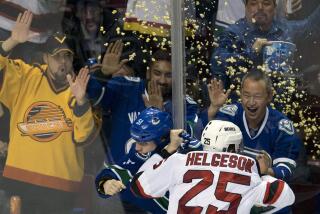NHL Looks Into Scoring Decline
- Share via
NEW YORK — The National Hockey League had a problem.
Defense dominated the 1928-29 season so much that teams combined for only 2.9 goals a game. A radical solution was adopted for the 1929-30 season: Allow players to make forward passes in the offensive zone.
The effect was immediate. Goal scoring doubled by December 1929.
With scoring at a 42-year low, some of the NHL’s leaders think its time for another radical move. Team executives and NHL Commissioner Gary Bettman have begun discussing ways to increase scoring.
“The forward pass was probably put in because the defense was too strong and they had to open up the game a little,” said Boston Bruins General Manager Harry Sinden, part of a nine-member committee that met in New York recently to discuss the problem. “That’s what we’re kind of looking at today. There’s a pretty wide opinion that the defensive tactics of teams have caught up with or passed the offense.”
Numbers back up the opinion. Through games of Dec. 22, an average of 5.3 goals were being scored a game, the lowest since the 5.1 average of the 1955-56 season. Last season’s 5.8 goals-a-game average matched the lowest full season total since 1969-70.
One change Sinden proposed was eliminating the offside rule -- which prohibits players from crossing the offensive blue line before the puck -- once the puck-carrying team has crossed the center red line. The rule could help create more space in the neutral zone because defensemen would be forced to cover players that try to get behind them.
Sinden said his idea would have to be thoroughly tested in other leagues before the NHL would consider trying it.
“I think it would spread the players out more and may have an effect on what has become a crowded area between the two blue lines,” he said.
Move Goal Line
Another possible change is moving the goal line out as much as three feet and pushing the blue lines back the same distance towards center ice, creating a larger offensive zone with more space behind the net and a smaller neutral zone.
Another possible rule change that was discussed was making the nets bigger. Several players, especially goalies, objected to the idea. Sinden said it wasn’t discussed at length.
“It came up, but it didn’t last very long,” he said.
Sinden said the group also discussed eliminating the center red line for two-line passes, a common rule throughout amateur and college hockey in the U.S., and forbidding goalies from stopping the puck behind the net.
Though allowing two-line passes would likely be the easiest rule to implement, Sinden said most general managers didn’t like the idea because it encourages teams to “float” players for a breakaway and would decrease passing plays through the neutral zone.
“There’s not too much sentiment for doing it,” Sinden said. “We’ve watched it and know the results of it and most of us don’t like it.”
Though others have mentioned increasing the size of the rink from its current 85-foot width and 200-foot length to create more space, too many new arenas have been built under the current dimensions to make a change practical, hockey executives said.
Bigger Players
While the rink size has remained the same, players have gotten bigger. Some players say the playing surface is too crowded.
“With the size and speed of the players they’re going to need more room,” said Steve McKenna, a 6-foot-8, 247-pound left wing with the Los Angeles Kings.
The average NHL player this season is 6-foot-1 and 200.2 pounds, marking the first time the league’s average weight is over 200 pounds. In 1971-72, the average NHL player was 5-foot-11, 184.2 pounds.
Other players disagree that the size of the players is what has created less room on the ice and point to the conservative playing style of teams as the reason goal scoring is down.
“It’s not so much the size of the players,” said Eric Lindros, the Philadelphia Flyers 6-foot-4, 230-pound center, “it’s the systems teams are playing.”
The decline in scoring can also be attributed to the amount of goals being disallowed because a player was in the goal crease, a rule added before last season. Through Dec. 22’s games, 61 goals have been disallowed because of crease violations, up from the 36 goals disallowed all of last season.
With four expansion teams set to join the league over the next three seasons, many general managers and players said more teams will be forced to play a defensive style to compete.
No matter what specific rule changes might be made, Sinden said something needs to be done to increase goal scoring if the NHL is going to gain popularity in the U.S.
“All sports make changes and most of the changes they make are to help the offense,” he said. “That’s where the entertainment value of sports is.”
More to Read
Go beyond the scoreboard
Get the latest on L.A.'s teams in the daily Sports Report newsletter.
You may occasionally receive promotional content from the Los Angeles Times.






